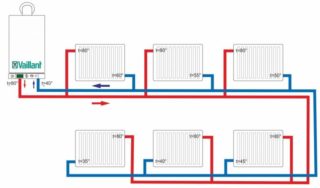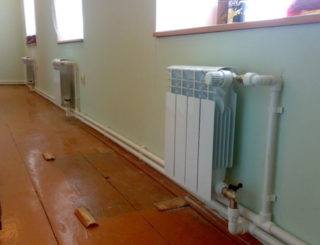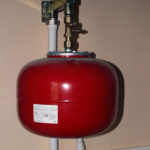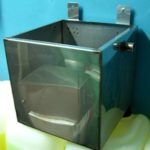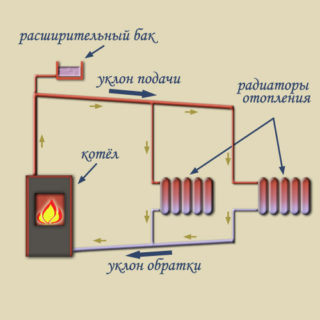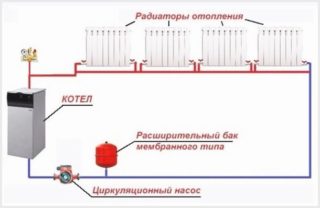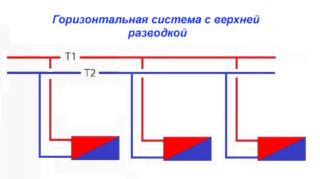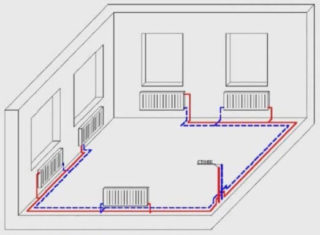A two-pipe heating system is one of the most popular ways to maintain a comfortable temperature in a private house. The water version is considered the most effective and practical in difficult climatic conditions. There are various connection schemes that are selected depending on the features of the building. Before you make heating in the house with your own hands according to a two-pipe scheme, you need to familiarize yourself with its varieties and distinguishing features of each type.
Features of two-pipe heating
All types of heating systems operating from a liquid coolant (water, antifreeze) have a closed loop. It connects to each other all the elements of heating: boiler, radiators.
Water moves through the heat exchanger and is heated to a high temperature. This value can be adjusted if special sensors and systems are installed. After heating, the fluid enters the radiators. All heat is transferred from the heated battery to the air and to surrounding objects. Gradually, the water cools and returns to the circuit, where again the heating cycle takes place.
In the case of single pipe systems, water flows only one pipe to each radiator. The two-pipe heating method is more complex. There are two pipes - water is supplied through one, and returns through the other. The second is also called the "return". This design avoids the main disadvantage of a single-tube system, which consists in the entry of a cooler coolant into the second, third and subsequent radiators. With a heating system with two pipes, the heat transfer of each section is almost the same.
System advantages
Two-pipe structures are more complex than using a single pipe. At the same time, they become the most popular way to heat a private and apartment building. Positive features:
- The water temperature is the same for each section of the circuit.
- You can adjust each battery. The owner can install thermostats on different radiators and adjust the device to the desired temperature. This will not affect the heat transfer of the remaining batteries in the house.
- Minimum pressure loss. Due to this property, a low-power circulation pump can be used.
- The system continues to function even after the failure of one of the batteries. When carrying out repairs, it is not necessary to turn off the heating throughout the house.
- It can be installed in a building with any number of floors and different sizes.
Among the disadvantages, only the complexity of installation and higher cost are distinguished due to the increased number of pipes.
Varieties of schemes
Two-pipe systems can be classified according to various criteria. There are open and closed circuits, as well as with natural and artificial circulation. The methods of connection and layout differ.
Open wiring
All hydraulic heating systems have a closed circuit with an expansion tank. It is necessary for the collection of excess fluid, which is formed as a result of heating. If the wiring is open, choose a tank in which water communicates with the atmosphere. Part of it will evaporate, so control of the coolant level will be required.
The advantages of an open circuit include the simplicity and low cost of the structure. Minus - fast lag of the coolant in the cold season due to contact with air. In addition, only water can be used in such wiring. Compounds of glycols and antifreeze during evaporation form harmful substances that poison the air.
Closed wiring
In such systems, a closed expansion tank is installed in which the liquid does not come into contact with the outside world. There is no need to control the water level. To protect against breakdowns, membrane tanks are installed in which compensation for a sharp decrease or increase in pressure occurs.
An important advantage of such a system is the ability to use any liquid as a coolant. Thanks to this, you can increase the efficiency of the system and save as much as possible.
- The tank in a closed system does not come in contact with air
- Open expansion tank for heating system
Natural circulation designs
The boiler heats the liquid to high temperatures. The density of the coolant decreases, as a result of which cold water displaces hot water upward.
When heat is transferred to the radiator, the liquid cools and increases the density. After that, it moves back to the double-circuit boiler and repeats the cycle again.
Advantages of the system:
- No excess air is formed. He manages to go to the upper point, while the coolant passes along the circuit.
- Duration of operation. It is associated with the absence of moving elements and complex mechanisms that can break.
Disadvantages:
- Slow work. The speed of movement also depends on many factors: the angle of inclination of the pipes, climatic conditions, the cross section of the pipeline.
- Larger diameter polypropylene pipes are required.
- The complexity of the design. Be sure to observe all angles, otherwise the coolant will not be able to move freely along the contour.
- Low pressure drop.
- Different radiators receive fluid of various temperatures. The farther the battery is from the boiler, the cooler the coolant gets into it.
The pumpless system is capable of self-regulation. The colder the room temperature, the faster the fluid will move through the pipeline. Also, the cross-section and material of the pipes, the number of turns, and the radii affect the speed.
Forced circulation
The main difference from systems with the natural movement of water is the presence of a pump. It forces the coolant to move along a closed heating circuit. In the case of using a pump, the design of the system is simplified, since the normal movement of the coolant will not be affected by external factors. Pump circuits are used most often.
Benefits:
- High speed.
- Reliability and stability.
- The most uniform heating of the batteries due to the receipt of a coolant of the same temperature. It is possible to adjust a separate radiator in each wing of the building.
- Possibility to install a membrane tank in a closed version.
- Installation is simplified, since strict observance of the pipe installation angle is not required.
- The ability to make changes to the design.
- Profitability.
An important minus is energy dependence. The pump will not work without being connected to electricity. To work in the country and with frequent problems with the power supply network, you may need a device with a battery. It is also necessary to take into account the costs of the pump itself and the valves necessary for its operation.
Horizontal and vertical line-up
The way to connect to the highway is horizontal and vertical. The number of vertical lines is minimal. In the case of horizontal laying, the processing pipes can be placed under the floor. A similar circuit cannot work without a circulation pump. It is installed in one- and two-story houses.
If connected to vertically located risers, there will be no air plugs. Such a system is installed in multi-storey residential buildings.The cost of a vertical system is higher than a horizontal one.
Top wiring
The upper collector system is characterized by laying supply pipes along the upper part of the room, and the return pipes along the lower.
Benefits:
- High pressure in the line.
- You can put pipes of the same diameter even in the case of natural circulation.
- A circulation pump can be installed to improve efficiency.
- High speed of movement of the heat carrier.
- No airway trunk.
- Possibility of installation in single-storey and multi-storey buildings.
Disadvantages:
- The design involves the installation of an expansion tank in the upper part of the house. This is usually an unheated attic, which can cause performance problems. Polypropylene insulation may be required.
- Unaesthetic appearance of the room with pipes laid under the ceiling.
- High consumption of pipes and accessories.
- It does not allow heating large areas.
- Difficulty placing the expansion tank.
In order for the system to have good efficiency, all the calculations must be completed in advance. To avoid mistakes, you may need the help of a professional who will take into account all the features of the room.
Bottom wiring
The system with the lower wiring involves the placement of pipes for supplying and discharging water below the batteries. The movement of the coolant in this case changes. First, it moves from bottom to top, enters the batteries and through the return pipe goes to the boiler. A circuit may have several circuits, as well as the associated fluid movement.
Excessive airing is noted in the system. To get rid of him, set the cranes of Majewski. If the cottage has several floors, such a system should be installed on each radiator. To avoid this, the installation of special overhead lines is recommended. They will collect excess air and direct it to the central riser. From it, the air masses move into the expansion tank and are removed from there.
Systems with lower wiring and natural circulation of the coolant are practically not used. This is due to limitations in use. For this reason, forced circulation of the coolant along the heating circuit is most often used.
The main positive qualities of the system with the lower wiring:
- Lack of visible highways. Such a system does not spoil the appearance of the room.
- Compact placement of the system control area. It can be installed in the basement of a private house.
- Heat losses are minimized. This is possible thanks to the lower gasket of the trunk.
- Such a system can work even during construction and repair work. When building a multi-storey building, you can heat the first floor, while work is underway on the second.
- Profitability. Heat can be distributed in the right amount to different rooms, so there will be no unnecessary expenses for heating an unused room.
Of the minuses, the need to purchase a large number of pipes and components can be noted. This increases the budget, which is designed for installation work. Also, the circuit has a low coolant pressure in the supply line.
The system must be monitored and vented through Maevsky’s taps, otherwise the performance will drop.
